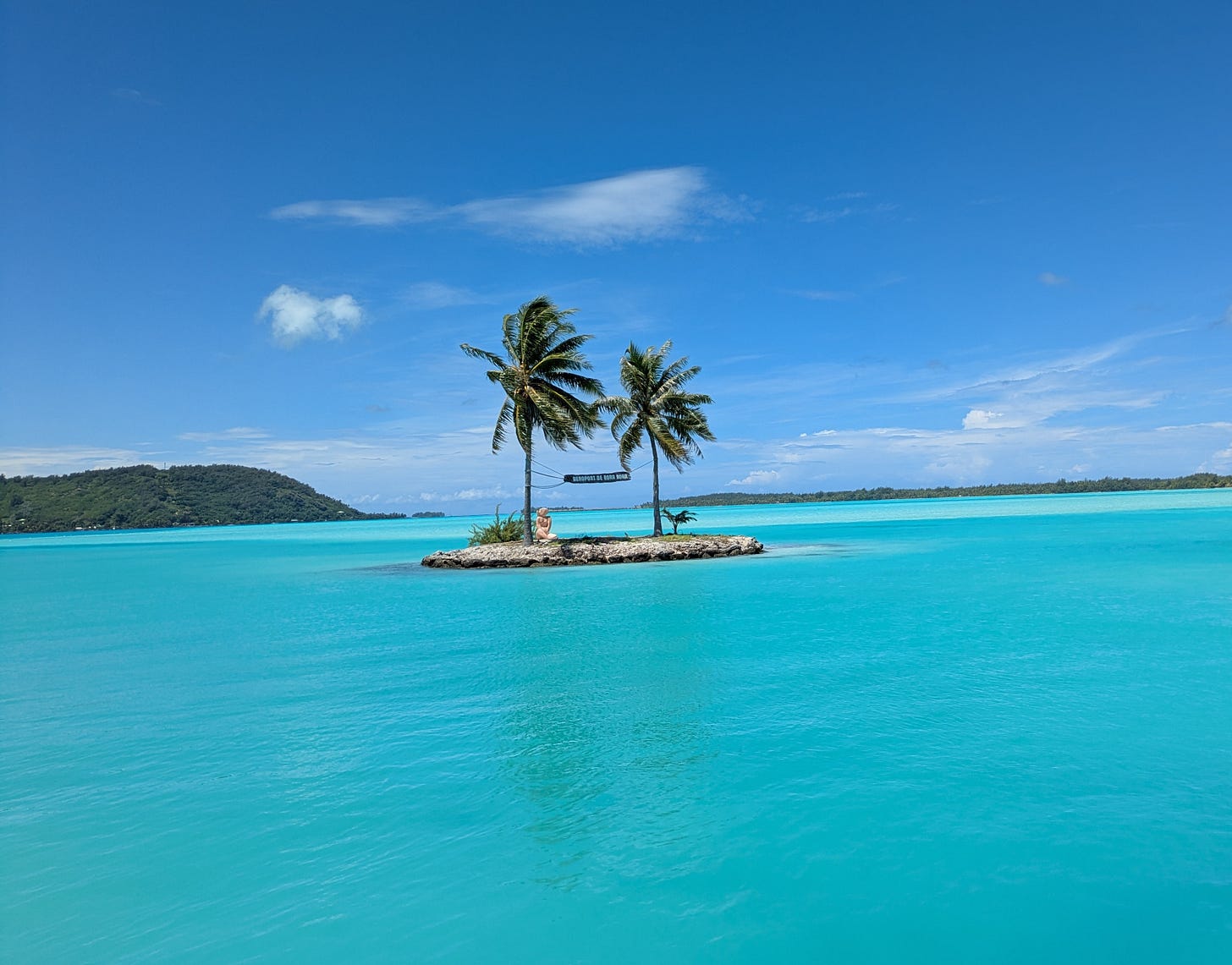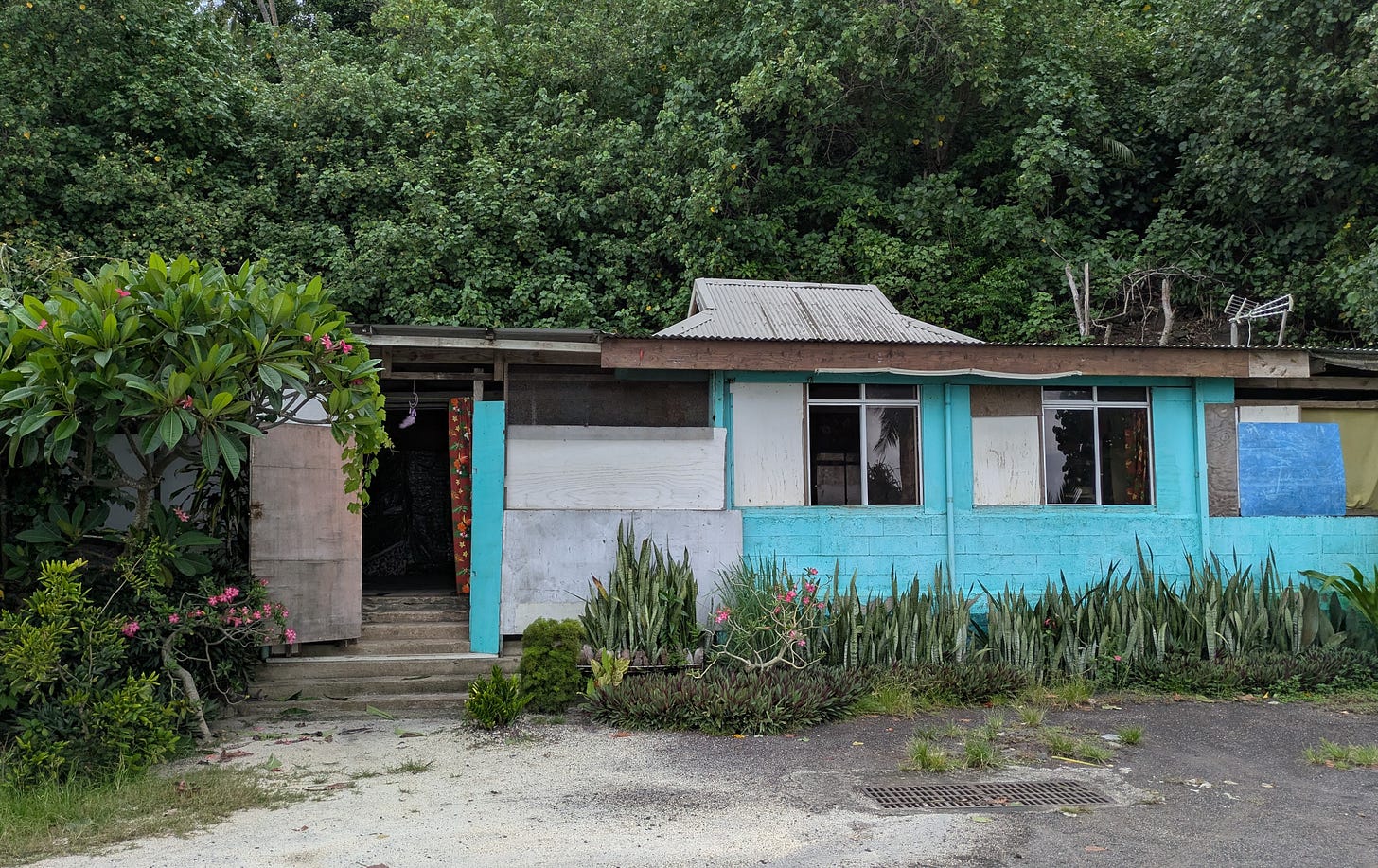Luxury Travel. A Matter of Perspective.
Bora Bora. Four Seasons Experience on a Two Seasons Budget
Imagine yourself here….
Bora Bora. As you stare out your window – the rain dripping down the glass panes or perhaps snow drifting in the driveway – do you imagine a turquoise sea as smooth as a mirror, thatched huts splayed over the placid water from where you and your beloved watch the sunset while tropical fish circle your glass-bottomed floor? In the morning an outrigger canoe glides up with breakfast: strong black coffee, fresh pineapple, mango, and coconut. This is the view of Bora Bora displayed in the slick ads of high-end travel magazines. It is the image that ran through my head when I booked a trip to Tahiti for My Guy, who’d dreamed of visiting Tahiti for the whole of our marriage.
Our dream vacation started with a seven-hour ferry ride from Papeete, Tahiti to the island of Bora Bora. We could have flown, but a ferry would allow us to see more of French Polynesia’s 121 islands. A ferry ride would be an adventure we thought. We were not wrong.
Our boat resembled an angry humpback whale that bucked and slammed the water with a ferocious desire to toss us into the waves like hapless cowboys at an ocean-going rodeo. The crew wandered the aisles passing out industrial-strength plastic bags for nauseous passengers and then retraced their steps to collect the bags and replace them with new ones.
“We’re definitely flying on the way back,” I told My Guy who sat placidly across from me, pen in hand, making notes.
“Sure. Fine. Can I read you the list of food I think we should pick up at the store when we arrive?”
“Can’t you see I’m busy,” I said burying my head further into my bag.
Our first morning in Bora Bora did not include waking up to a buff, beautifully tattooed Tahitian god paddling up to our bungalow with breakfast. We woke up to no electricity.
“I bet they have power at the Four Seasons,” I said eying the row of five-star villas on stilts directly across the lagoon from us.
“We are not on a Four Seasons budget,” MG politely reminded me.

Oregon in February is messy. When we left home there was snow on the ground. What better way to survive the winter blues than to trade them for the blue sky and bluer water of French Polynesia? That was the plan anyway when I booked our Airbnb, which although not on stilts was close enough to the water that I could stick my toes in it from the bungalow’s deck.
Travel planning has never been my forte. I expect to just figure things out once I get there. It’s my one act of spontaneity.
“Did you know that February is the most common month for typhoons in Bora Bora? I read the guidebook aloud to My Guy. I had to read it to him twice. It was hard to hear above the fifty-mile-an-hour winds pounding the surf and sending the rain sideways.
“I do now,” he said squinting out the window at the row of palm trees. Their long feathered branches were bent at 90-degree angles from their trunks making them look like giant pinwheels. He showed me a screenshot on his phone. We were looking at a week’s worth of rain and lightning storms. Ah well.
We took the opportunity during a break in the weather to walk to the store for a six-pack of beer. It was a 2.5-mile walk to the nearest town, consisting of a school, a church, and a small, but adequate grocery store. Along the way, we passed houses made of concrete blocks and plywood or corrugated metal with muddy swamps for yards. Swaths of colorful cotton cloth swayed in open doorways.
Residents were outside sweeping up palm fronds and coconuts. ‘la ora na they sang out as we walked by. ‘la ora na we responded which means hello and is pronounced “yoranna.” Dogs lay in the middle of the street barely lifting their heads when we – or cars – passed by. Our route took us past a landfill, several dozen abandoned buses and cars, and, right on the beach, a junkyard piled high with cars and tires.
When we returned to our bungalow, I looked up the average salary for Polynesia: just shy of $15,500 a year. It’s a short kayak paddle from the main island to the five-star resorts lining the lagoon, but the economic chasm between the two worlds is wide.
This is the view of Bora Bora you don’t see in the slick ads. On one side of the lagoon are rooms that cost thousands of dollars a night and on the other a landfill and a junkyard heaped high with rusted-out automobiles.
Not to say that those full-page photos in travel magazines have it wrong. When the weather finally cleared, we discovered that the water was crystalline, the sunsets world-class, and the coral reef, the manta rays, the sharks – all spectacular.
But, the storms pulled at the edges of paradise’s plastic-perfect facade. While we weren’t able to fully indulge in the relaxing tropical vacation we’d envisioned – the one where we spent our days kayaking, biking, and snorkeling, we were able to engage, even if only at a superficial level, with the people and place.
I am, as always when outside my neighborhood bubble, a voyeur. I couldn’t begin to know Bora Bora except as a tourist who sees half the story and is not sure of its interpretation. Was I part of the problem or contributing to the economic viability of a place reliant on tourism?
We stayed in French Polynesia for two weeks. I don’t speak Tahitian or French beyond “hello” and “thank you.” I couldn’t identify the fruit on the trees growing roadside. Breadfruit? Mango?
What else couldn’t I identify in this place?
On the last leg of our ferry ride, I closed my eyes. My stomach still roiling, I listened to the boat slamming against the waves. I heard the hum of the boat engines. The spray of the waves and rain on the windows sounded as if someone had taken out the garden hose. And then, weaving its way through this nautical symphony came the lyrical sound of ukuleles and a woman’s voice. I opened my eyes to see three men and a woman serenading passengers with a love song. To Bora Bora.









Great post!
What a postcard! I love your honesty.